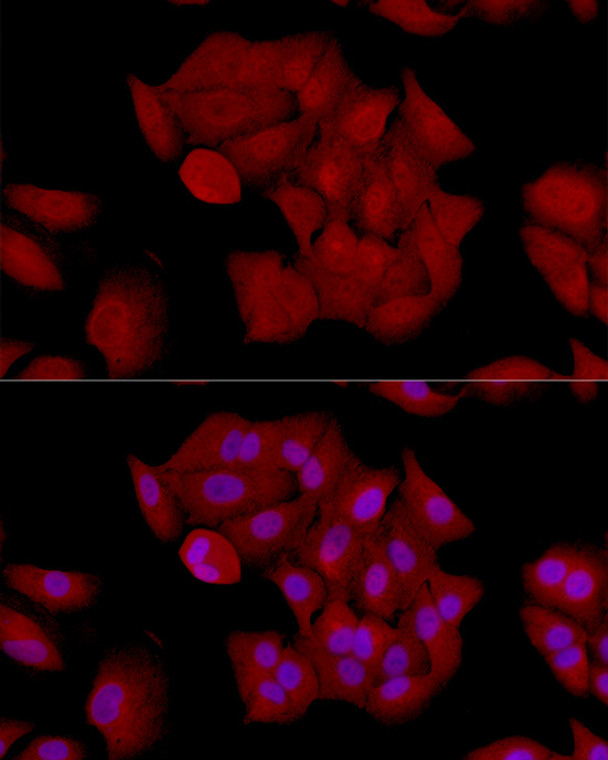| Host: |
Rabbit |
| Applications: |
WB/IHC/IF |
| Reactivity: |
Human/Mouse/Rat |
| Note: |
STRICTLY FOR FURTHER SCIENTIFIC RESEARCH USE ONLY (RUO). MUST NOT TO BE USED IN DIAGNOSTIC OR THERAPEUTIC APPLICATIONS. |
| Short Description: |
Rabbit polyclonal antibody anti-GLI1 (350-450) is suitable for use in Western Blot, Immunohistochemistry and Immunofluorescence research applications. |
| Clonality: |
Polyclonal |
| Conjugation: |
Unconjugated |
| Isotype: |
IgG |
| Formulation: |
PBS with 0.05% Proclin300, 50% Glycerol, pH7.3. |
| Purification: |
Affinity purification |
| Dilution Range: |
WB 1:500-1:1000IHC-P 1:50-1:200IF/ICC 1:50-1:200 |
| Storage Instruction: |
Store at-20°C for up to 1 year from the date of receipt, and avoid repeat freeze-thaw cycles. |
| Gene Symbol: |
GLI1 |
| Gene ID: |
2735 |
| Uniprot ID: |
GLI1_HUMAN |
| Immunogen Region: |
350-450 |
| Immunogen: |
A synthetic peptide corresponding to a sequence within amino acids 350-450 of human GLI1 (NP_001153517.1). |
| Immunogen Sequence: |
LSSLDEGPCIAGTGLSTLRR LENLRLDQLHQLRPIGTRGL KLPSLSHTGTTVSRRVGPPV SLERRSSSSSSISSAYTVSR RSSLASPFPPGSPPENGASS L |
| Tissue Specificity | Detected in testis (at protein level). Testis, myometrium and fallopian tube. Also expressed in the brain with highest expression in the cerebellum, optic nerve and olfactory tract. Isoform 1 is detected in brain, spleen, pancreas, liver, kidney and placenta.isoform 2 is not detectable in these tissues. |
| Post Translational Modifications | Phosphorylated in vitro by ULK3. Acetylation at Lys-518 down-regulates transcriptional activity. Deacetylated by HDAC1. Ubiquitinated by the CRL2(FEM1B) complex, suppressing GLI1 transcriptional activator activity. |
| Function | Acts as a transcriptional activator. Binds to the DNA consensus sequence 5'-GACCACCCA-3'. Regulates the transcription of specific genes during normal development. Plays a role in craniofacial development and digital development, as well as development of the central nervous system and gastrointestinal tract. Mediates SHH signaling. Plays a role in cell proliferation and differentiation via its role in SHH signaling. Isoform 2: Acts as a transcriptional activator, but activates a different set of genes than isoform 1. Activates expression of CD24, unlike isoform 1. Mediates SHH signaling. Promotes cancer cell migration. |
| Protein Name | Zinc Finger Protein Gli1Glioma-Associated OncogeneOncogene Gli |
| Database Links | Reactome: R-HSA-5610780Reactome: R-HSA-5610787Reactome: R-HSA-5632684Reactome: R-HSA-5635851 |
| Cellular Localisation | CytoplasmNucleusTethered In The Cytoplasm By Binding To SufuActivation And Translocation To The Nucleus Is Promoted By Interaction With Stk36Phosphorylation By Ulk3 May Promote Nuclear LocalizationTranslocation To The Nucleus Is Promoted By Interaction With Zic1Isoform 2: Cytoplasm |
| Alternative Antibody Names | Anti-Zinc Finger Protein Gli1 antibodyAnti-Glioma-Associated Oncogene antibodyAnti-Oncogene Gli antibodyAnti-GLI1 antibodyAnti-GLI antibody |
Information sourced from Uniprot.org
12 months for antibodies. 6 months for ELISA Kits. Please see website T&Cs for further guidance












